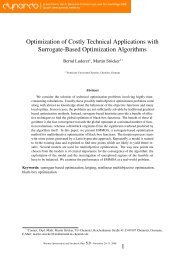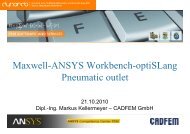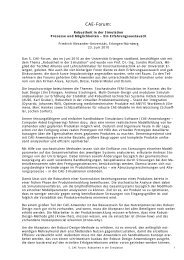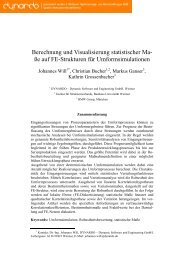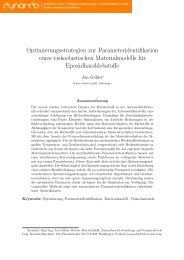Robustness Analysis of a mobile Phone
Robustness Analysis of a mobile Phone
Robustness Analysis of a mobile Phone
You also want an ePaper? Increase the reach of your titles
YUMPU automatically turns print PDFs into web optimized ePapers that Google loves.
1<br />
<strong>Robustness</strong> Evaluation <strong>of</strong><br />
Mobile <strong>Phone</strong> Drop Test Simulation<br />
Gerald Grewolls<br />
Alexander Ptchelintsev<br />
This material, including documentation and any related computer programs, is protected by copyright controlled by Nokia. All rights are reserved.<br />
Copying, including reproducing, storing, adapting or translating, any or all <strong>of</strong> this material requires the prior written consent <strong>of</strong> Nokia. This material also<br />
contains confidential information, which may not be disclosed to others without the prior written consent <strong>of</strong> Nokia.<br />
© 2010 Nokia All Rights Reserved Gerald Grewolls 22-Oct-2010
Contents<br />
• Mechanical Requirements for Mobile <strong>Phone</strong>s<br />
• Challenges in Drop Test Simulation<br />
• Sensitivity & <strong>Robustness</strong> Study for Varying Drop Orientation<br />
• Step 1: Sensitivity analysis<br />
• Examples for Results<br />
• Next Steps<br />
• Summary<br />
2 © 2010 Nokia All Rights Reserved Gerald Grewolls 22-Oct-2010
Mechanical Requirements for Mobile <strong>Phone</strong>s<br />
• Nokia's technical specification requires very high mechanical reliability<br />
• Mechanical loads comprise drop, bend, twist, impact <strong>of</strong> hard objects and others<br />
• One <strong>of</strong> the hardest requirements: No failure in repeated, randomly oriented drops on<br />
a hard floor.<br />
Most sensitive components: display and printed wiring board (PWB)+soldered parts<br />
• Impact orientation is randomly distributed<br />
� difference to car crash simulation, where impact direction is defined by legal<br />
regulations.<br />
• At Nokia, mechanical simulation is applied widely to support early design process<br />
3 © 2010 Nokia All Rights Reserved Gerald Grewolls 22-Oct-2010
Challenges in Drop Test Simulation<br />
• Stress results in components are very sensitive to the drop orientation<br />
• Generally the drop on a corner with 2 or more subsequential impacts ("clattering")<br />
leads to maximum stresses<br />
• For different drop orientations strongly non-linear variation <strong>of</strong> results due to<br />
different contact histories which are sensitive to small angle changes<br />
• Geometric and material non-linearities to be considered additionally<br />
4 © 2010 Nokia All Rights Reserved Gerald Grewolls 22-Oct-2010
<strong>Robustness</strong> Evaluation for Varying Drop Orientation<br />
Two important questions to answer:<br />
How to find the design-relevant drop orientation (worst case) ?<br />
How to verify that proposed design improvements for one impact direction lead to<br />
allowed loadings for arbitrary impact orientations as well?<br />
Step 1: Numerical sensitivity analysis with OptiSlang:<br />
• Determine "worst case" drop test orientation for each output variable.<br />
• Evaluate most efficient optimisation variables and optimisation potential<br />
Step 2:<br />
• Find design modifications to comply with failure criteria<br />
• Verify robustness <strong>of</strong> these modifications against deviations <strong>of</strong> the drop orientation by<br />
simulation-based optimisation<br />
Step3:<br />
• Evaluate robustness <strong>of</strong> the solution against material scatter and production tolerances<br />
With the estimation <strong>of</strong> scatter, safety margins can be extracted and implemented in<br />
the deterministic design process to ensure robust structures.<br />
5 © 2010 Nokia All Rights Reserved Gerald Grewolls 22-Oct-2010
Step 1:<br />
Sensitivity <strong>Analysis</strong> for the Drop Orientation<br />
• Interesting for sensitivity and robustness study: influence <strong>of</strong> drop orientation<br />
to the mechanical loads on phone components<br />
• Investigated load case: horizontal position with small inclination<br />
• The sensitivity to geometric and material parameters is lower than that<br />
to drop orientation angles<br />
• Input parameters for this work: 2 angles which define the drop orientation<br />
• Output parameters: Stress results in<br />
• display glass,<br />
• display driver IC,<br />
• window glass<br />
ANGLE_X<br />
6 © 2010 Nokia All Rights Reserved Gerald Grewolls 22-Oct-2010<br />
ANGLE_Y
Examples for Results<br />
• Pictures in previous pages were examples for existing products.<br />
• The following results are from a new product which was not yet<br />
published – no design pictures can be shown here.<br />
• The results represent a very early development stage where many<br />
modifications are ongoing.<br />
7 © 2010 Nokia All Rights Reserved Gerald Grewolls 22-Oct-2010
Example for Result: Stress at Glass Window Edge<br />
Conclusion: Horizontal position (0°,0°) is less critical than impact on corners.<br />
Investigate possible modifications to decrease stress peaks for ANGLE_X=-3°.<br />
8 © 2010 Nokia All Rights Reserved Gerald Grewolls 22-Oct-2010
Example for Result: Stress in Display Driver IC<br />
Conclusion: Extension <strong>of</strong> angle range is required to identify worst case orientation.<br />
9 © 2010 Nokia All Rights Reserved Gerald Grewolls 22-Oct-2010
Example for Result: Stress in Display Glass<br />
Conclusion: Extension <strong>of</strong> angle range is required to identify worst case orientation.<br />
Investigate possible modifications to decrease stress for orientations around (-4°,-4°).<br />
10 © 2010 Nokia All Rights Reserved Gerald Grewolls 22-Oct-2010
Traffic Light Plot (new in OptiSlang 3.2.0)<br />
11<br />
Compare selected output parameters to safety limits (yellow) and failure limits (red).<br />
Due to the random character <strong>of</strong> the drop orientation also the<br />
range [mean value + standard deviation] is a criterion to evaluate the risks to exceed<br />
failure limits in drop test.<br />
© 2010 Nokia All Rights Reserved Gerald Grewolls 22-Oct-2010
Conclusions from step 1 (sensitivity analysis)<br />
•The angle range should be increased to capture all critical<br />
drop orientations<br />
•Some "worst-case-orientations" were found, these<br />
orientations for maximum stress results are hardly to predict<br />
on the basis <strong>of</strong> theory or engineering experience.<br />
•Strongly non-linear character <strong>of</strong> results, Coefficients <strong>of</strong><br />
Prognosis are relatively low due to steep result peaks which<br />
are randomly distributed. Result animations <strong>of</strong> the samples<br />
with the maximum stress deliver plausible pictures.<br />
12 © 2010 Nokia All Rights Reserved Gerald Grewolls 22-Oct-2010
Next steps (Modification and <strong>Robustness</strong> <strong>Analysis</strong>)<br />
•Implement structural modifications to decrease stress levels for<br />
worst-case orientations<br />
•Evaluate robustness <strong>of</strong> the modifications by use <strong>of</strong> OptiSlang<br />
13 © 2010 Nokia All Rights Reserved Gerald Grewolls 22-Oct-2010
Summary<br />
• The design-relevant impact direction for drop simulation is unknown -<br />
sensitivity analysis is an appropriate and efficient tool to identify worst-case<br />
orientations.<br />
• The stochastic approach for load case definition ensures to cover risks much<br />
better than deterministic investigation – by dense coverage <strong>of</strong> the space <strong>of</strong><br />
possible impact orientations.<br />
• Important precondition: availability <strong>of</strong> powerful simulation hardware for<br />
parallel solving <strong>of</strong> explicit FEM simulations<br />
• Very robust simulation models are required to get valid results.<br />
• Future work will focus to develop sensitivity and robustness analyses as a<br />
standard for each product: criteria for validity <strong>of</strong> results, number <strong>of</strong> required<br />
samples, FEM model robustness must be defined.<br />
14 © 2010 Nokia All Rights Reserved Gerald Grewolls 22-Oct-2010












